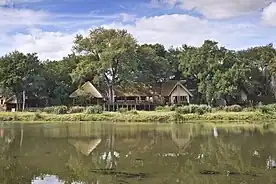Ecoscaping
Ecoscaping is a spatial planning discipline that integrates landscape architecture and environmental science to create sustainable designs or construction. The approach of Ecoscaping is holistic and strives to respect the pre-existing materials, microenvironments, and structures (backyards, cities, campuses, etc.) in sustainable land use management with ecological balance.[1]


An "ecoscape" represents a landscape or seascape that goes beyond political divisions and, instead, establishes boundaries that prioritize the preservation of ecological functions and the fulfillment of human requirements for thriving environments.[2] As ecoscapes are rooted in specific locations rather than constrained by political borders, they present fresh, large-scale prospects for environmental restoration.[2] On a psychological level, humans are inherently inclined to restore places that hold significance for the quality and character of their lives. Harnessing this motivation can yield advantages for all species.[2]
While landscapes are continually evolving, and new ecosystems are constantly emerging, the concept of ecoscape thinking serves as a driving force for restoration efforts.[2] It directs human attention, including our legal frameworks, toward our connection with the broader environment and our responsibility in preserving rapidly disappearing ecosystems.[2]
Consequently, ecoscapes can adapt in size, expanding or contracting based on the level of commitment humans are willing to invest in restoring ecosystem functions.[2] Overemphasizing ecological aspects rather than socio-ecological factors downplays the significance of governance in the success of large-scale restoration initiatives.[2] This growing emphasis underscores the value of extensive landscapes and seascapes for communities, as they are managed with the objective of conserving nature, which, in turn, delivers economic, social, and ecological advantages.[2]
Process
Ecoscaping searches for solutions to improve the look of a property while making minimal impact on the surrounding environment, protecting biodiversity and wildlife habitats, achieving nature conservation and ecological balance.[1]
Examples of Ecoscaping techniques include:
- Using natural products instead of artificial decoration
- Planting trees and minimizing the use of pesticides and artificial fertilizers
- Creating out-buildings, decks, trellises, etc. that work in with the land.
- Rainwater harvesting
- Creating a self-contained water reservoir for water balance.
Significance
Ecoscaping is a process of building and rebuilding based on nature, sustainable development, and human aesthetics. Ecoscaping provides an alternative to harsh land use practices with ecologically adverse effects, such as impervious surfaces, soil compaction, contamination, and urban sprawl.
References
- "The Basics of Ecological Landscaping". 20 October 2008.
- Telesetsky, Anastasia (2012). "ECOSCAPES: THE FUTURE OF PLACE-BASED ECOLOGICAL RESTORATION LAWS" (PDF). Vermont Journal of Environmental Law: 7–34.